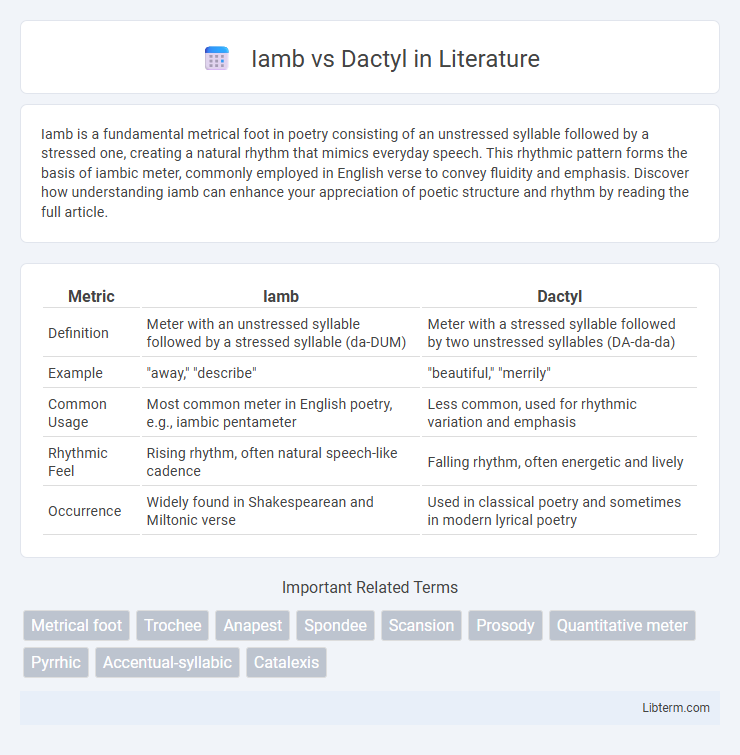Iamb is a fundamental metrical foot in poetry consisting of an unstressed syllable followed by a stressed one, creating a natural rhythm that mimics everyday speech. This rhythmic pattern forms the basis of iambic meter, commonly employed in English verse to convey fluidity and emphasis. Discover how understanding iamb can enhance your appreciation of poetic structure and rhythm by reading the full article.
Table of Comparison
| Metric | Iamb | Dactyl |
|---|---|---|
| Definition | Meter with an unstressed syllable followed by a stressed syllable (da-DUM) | Meter with a stressed syllable followed by two unstressed syllables (DA-da-da) |
| Example | "away," "describe" | "beautiful," "merrily" |
| Common Usage | Most common meter in English poetry, e.g., iambic pentameter | Less common, used for rhythmic variation and emphasis |
| Rhythmic Feel | Rising rhythm, often natural speech-like cadence | Falling rhythm, often energetic and lively |
| Occurrence | Widely found in Shakespearean and Miltonic verse | Used in classical poetry and sometimes in modern lyrical poetry |
Understanding Iamb and Dactyl: Definitions
Iamb and dactyl are two fundamental metrical feet in poetry used to create rhythmic patterns. An iamb consists of an unstressed syllable followed by a stressed syllable, as in the word "describe," while a dactyl features a stressed syllable followed by two unstressed syllables, exemplified by the word "beautiful." Understanding these definitions helps poets structure verses with desired cadence and emotional impact.
The Structure of Iambic Meter
Iambic meter consists of metrical feet with an unstressed syllable followed by a stressed syllable, creating a da-DUM rhythm that closely mirrors natural English speech patterns. This structure allows poets to build lines that flow smoothly and emphasize key words, often used in sonnets and blank verse. The alternating unstressed and stressed syllables in iambic meter contrast sharply with the dactyl, which features a stressed syllable followed by two unstressed syllables, establishing a different rhythmic effect.
The Structure of Dactylic Meter
Dactylic meter consists of a stressed syllable followed by two unstressed syllables, forming a long-short-short pattern that creates a rhythmic, flowing cadence in poetry. This contrasts with the iambic meter, which features an unstressed syllable followed by a stressed one, producing a short-long rhythm. The triple syllable structure of dactylic meter is often used in epic poetry to convey grandeur and momentum.
Key Differences Between Iamb and Dactyl
Iamb and dactyl differ primarily in their metrical patterns: an iamb consists of an unstressed syllable followed by a stressed syllable (da-DUM), while a dactyl contains one stressed syllable followed by two unstressed syllables (DA-da-da). The iamb is commonly used in English poetry and speech, producing a rising rhythm, whereas the dactyl creates a falling rhythm often found in classical Latin and Greek poetry. These distinct rhythmic structures influence the tone and pacing of verses, making iambs suited for natural speech patterns and dactyls more rhythmic and melodic.
Historical Origins of Iamb and Dactyl
The iamb originated in ancient Greek poetry as a metrical foot consisting of an unstressed syllable followed by a stressed syllable, instrumental in classical tragedy and epic poetry. The dactyl, characterized by one stressed syllable followed by two unstressed syllables, was prominent in Greek hexameter verse, notably used by Homer in the Iliad and the Odyssey. Both meters influenced Latin and later European poetic traditions, shaping the rhythmic foundations of Western literature.
Famous Examples of Iambic Poetry
Iambic meter, characterized by an unstressed syllable followed by a stressed one, is famously employed in Shakespeare's sonnets and many of his plays, such as "Romeo and Juliet" and "Hamlet." This rhythmic pattern creates a natural flow that mirrors everyday speech, enhancing the emotional depth and dramatic tension. In contrast, dactylic meter, with its stressed syllable followed by two unstressed syllables, is less common in English poetry but appears in works like Henry Wadsworth Longfellow's "Evangeline.
Renowned Dactylic Verses in Literature
Renowned dactylic verses in literature include Henry Wadsworth Longfellow's "Evangeline," which demonstrates the rhythmic pattern of a stressed syllable followed by two unstressed syllables, creating a flowing, melodic effect. In contrast to the iambic meter, dactylic meter imparts a more rolling and galloping cadence, making it distinct in epic poetry and ballads. Classical examples also feature dactylic hexameter in Homer's "Iliad" and "Odyssey," foundational works that showcase the powerful and rhythmic drive characteristic of this verse form.
Effects of Rhythm: Iamb vs Dactyl in Tone
Iambic rhythm creates a natural, flowing tone often associated with calmness or seriousness, as its unstressed-stressed pattern mimics natural speech. Dactylic rhythm, characterized by a stressed-unstressed-unstressed pattern, evokes a more energetic, lively, or even urgent tone due to its rapid and falling cadence. The choice between iamb and dactyl significantly shapes the emotional atmosphere and pacing in poetry and prose.
Usage in Modern and Classical Poetry
Iambs, consisting of an unstressed syllable followed by a stressed syllable, dominate both modern and classical poetry for their natural rhythm that closely mimics everyday speech patterns. In contrast, dactyls, with one stressed syllable followed by two unstressed syllables, appear more frequently in classical poetry, such as Homeric epics, to create a flowing, melodic effect. Contemporary poets use dactyls sparingly to add rhythmic diversity, while iambs remain the foundational meter in modern English verse, including sonnets and blank verse.
Choosing Between Iamb and Dactyl in Writing
Choosing between iamb and dactyl in writing depends on the rhythm and emphasis desired in a poem or prose. Iambs, with their unstressed-stressed pattern, create a natural, flowing cadence ideal for reflective or dramatic tones, while dactyls, featuring a stressed-unstressed-unstressed pattern, impart a lively, energetic, and sometimes playful feel. Writers optimize emotional impact and pacing by matching meter choice to the intended mood and thematic nuance of their work.
Iamb Infographic

 libterm.com
libterm.com